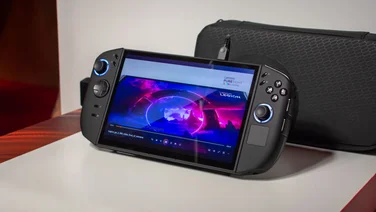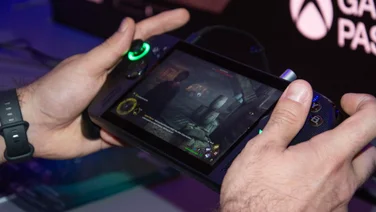To help us provide you with free impartial advice, we may earn a commission if you buy through links on our site. Learn more
- Xbox Series X review: What you need to know
- Xbox Series X review: Price and competition
- Xbox Series X review: Design and key features
- Xbox Series X review: Controller
- Xbox Series X review: Performance and user interface
- Xbox Series X review: Launch games, backwards compatibility and Xbox Game Pass
- Xbox Series X review: Verdict














- 4K gaming at stable frame rates
- Blisteringly fast load times
- Ray-tracing comes to consoles
- ‘Quick Resume’ is seamless
- Expensive
- Sparse launch lineup
- 120Hz setting limited to HDMI 2.1 TVs
With every new console generation comes some degree of graphical enhancement. The jump from the 16-bit era to fully 3D-rendered polygonal textures with the launch of the original PlayStation in the mid-90s is perhaps the most memorable turning point, closely followed by the introduction of 720p HD gaming with the Xbox 360 and PlayStation 3.
READ NEXT: The best TVs for next-gen gaming
In recent years, however, graphical tweaks have been more minor and in the case of the Xbox Series X (and to some extent the PS5), it’s less about what games look like and more about how games play. Sluggish load times, unreliable frame rates and fluctuating rendering resolutions are the problems this latest generation of consoles are designed to address – and they’re finally a thing of the past.
Xbox Series X review: What you need to know
While the Xbox One X – as well as the PS4 Pro – were the first 4K-capable games consoles, the Xbox Series X offers some significant improvements in the processing department. Where most titles previously maxed out at 30fps, with the resolution often dipping below native 4K during gameplay, the Xbox Series X promises stable 60fps gaming at 4K resolution and even 120fps in some instances. Microsoft also claims that the Series X is future-proofed for 8K rendering, although no titles support this resolution at launch.














Powered by a custom-designed 3.8GHz AMD Zen 2 CPU, 16GB of GDDR6 RAM and an AMD RDNA 2 GPU, the Xbox Series X’s graphics processing power is quoted at 12 teraFLOPS, which is double that of the One X’s comparatively meagre six teraFLOPS. Loading times are greatly improved, too, with the Xbox Series X finally making the move from a mechanical hard disk to a speedy 1TB NVMe SSD.
READ NEXT: See how the Xbox Series X compares to the PS5 in our head-to-head
Xbox Series X review: Price and competition
How much is all of this extra horsepower going to set you back? Well, it’s no surprise that the Xbox Series X doesn’t come cheap. Priced at £450 in the UK, the Xbox Series X costs the same as the full-fat PS5 (the digital-only version is £100 less). It also happens to have an identical launch price to the Xbox One X, which first showed up in TV cabinets three years ago.
The Series X’s main competition comes from within Microsoft’s own ranks, butting heads against the cheaper Xbox Series S, as well as the Xbox One X, which was recently discontinued but you might be able to do some digging and find one for around £380.
Launching alongside the X, the Xbox Series S costs £200 less at £250 but only has four teraFLOPS of processing potential, a smaller 512GB NVMe SSD and output is restricted to a maximum resolution of 1,440p with 4K upscaling.














What about the PS5, I hear you cry? Comparatively speaking, at least, Sony’s next-gen console isn’t quite as powerful, since it uses a slightly slower CPU, has only 10.3 teraFLOPS of graphics grunt as well as a smaller 825GB SSD. The PS5’s launch games lineup is more impressive, however, which I’ll discuss in more detail later in this review.
Xbox Series X review: Design and key features
Unlike the PS5, the Xbox Series X isn’t particularly flashy in terms of its design. The internal hardware is its most exciting aspect and Microsoft is clearly hoping that the Series X’s superior specifications are enough of a selling point.
READ NEXT: Best Xbox controllers
In short, the Xbox Series X is a big, black, rectangular monolith. The use of the word “big” is definitely something of an understatement in this instance, too, since the Series X is the second-largest Microsoft console to date, second only to the original One. Designed to sit upright (expelling hot air via the top-mounted fan), the Series X measures 301mm tall, which is much larger than any available space in my TV cabinet.














In fact, my Xbox Series X has been sitting on my living room floor in the last couple of weeks, just like my Windows PC (it actually looks a lot like a Mini-ITX PC case). This isn’t ideal, since it’s at risk of water damage when I tend to the various house plants dotted about my flat but there’s simply nowhere else to put it. It is possible to place the Xbox Series X on its side, of course, but its circular stand can’t be removed, so it does look a bit odd.
On the front of the console, you’ll find a slot for the 4K Blu-ray drive, as well as a USB 3.1 Gen 1 port (5Gbits/sec) and circular Xbox power button, which lights up when pressed and switched on. The back of the Xbox is much more exciting, with a further two USB 3.1 Gen 1 ports, power connector, HDMI 2.1 port, Gigabit Ethernet, and an unusual storage expansion port.
This weird little connector is reserved for one of Seagate’s proprietary 1TB expansion cards. Costing almost half the price of the console itself (£220), this high-bandwidth PCIe NVMe card uses the same type of storage as the internal drive and is the only way to play ‘Optimised for Xbox Series X’ games from an external source. You can still plug in a trusty USB hard drive or SSD, of course, but this method can only be used for older titles or non-optimised versions of games.
Xbox Series X review: Controller
The standard Xbox One controller has also seen a slight upgrade, although the changes here aren’t quite as drastic. The design of the Series X’s controller is mostly the same but it now has textured rear grips and triggers. It can also connect via USB-C (as well as Bluetooth with a pair of AA batteries) although Microsoft doesn’t include a USB-C cable in the box.














The controller’s directional pad has been replaced in favour of a dish-shaped d-pad, not unlike the one found on the Xbox Elite 2 controller. In the middle, between the small ‘menu’ and “change view” buttons, you’ll also find the new share button, which allows you to capture 4K screenshots and game clips with either a short or long-press and upload them directly to social media.
Xbox Series X review: Performance and user interface
If you’re already an Xbox owner then you will feel right at home when it comes to the user interface. The Series X is running the latest version of Microsoft’s Xbox dashboard and it uses the same tiled app layout as the previous generation. The pop-up settings sidebar that appears whenever you press the Xbox button on your controller while playing a game is the same, too.
READ NEXT: Best Xbox Series X external hard drives
Functionally, at least, the Series X’s dashboard might be identical, but its newfound power makes a massive difference when navigating around. The Microsoft Store opens in the blink of an eye and you’re now able to cycle through the exhaustive list of Game Pass games at breakneck speed – an area where the One X usually struggles.














On that note, it’s finally time to talk about gaming performance. As I said earlier, the Xbox Series X is the most powerful games console yet, with double the graphics processing power of the Xbox One X and more graphical oomph (at least on paper) than the PlayStation 5.
As you might expect, in the games we’ve tested it’s clear that this upgrade provides a substantial improvement in both graphical fidelity and frame rates. Where the Xbox One X would occasionally dip below 30fps targets and tweak the rendering resolution below 4K to compensate for its lack of power, the Series X does nothing of the sort. Gameplay never dropped below 30fps in testing (most games target 60fps, in fact) and it almost always rendered at native 4K resolution.
The Xbox Series X also supports hardware-accelerated DirectX ray-tracing in certain games. Simply put, this is an advanced method of simulating the way in which light travels around a scene, with more accurate reflections in street puddles, shop windows and the like. As an example, Ubisoft’s grim, post-Brexit vision of London in Watch Dogs: Legion looked absolutely stunning, with gunshot muzzle flash reflections bouncing off car doors and nearby explosions engulfing reflective mirrored surfaces.
Games such as Dirt 5 also have the option to run at 120fps at a downsampled 1,440p, with only a slight downgrade in graphical fidelity. This isn’t something I’ve been able to test, though, since this requires a TV with an HDMI 2.1 input. These TVs are also hideously expensive at the time of writing and there aren’t many to choose from, either.
On a more positive note, the Series X’s load times are greatly improved. I tested a variety of games, timing how long it takes to launch and begin gameplay and in most cases, the Series X’s 1TB NVME SSD cut those times in half. Red Dead Redemption 2 for instance, loaded in just over one minute, compared to the One X’s thumb-twiddling two-and-a-half minutes.
The Series X’s speedy storage is also put to good use when it comes to the new Quick Resume feature. In my view, this is the Series X’s headline act: it allows you to simply switch between games, pausing one game and beginning where you left off on another in an instant. There doesn’t seem to be a limit on how many games you can cycle through, either – just make sure that the power mode is set to ‘instant on’, otherwise you will lose your progress when you switch the console off.
As a side note, the Xbox Series X is a wonderfully quiet machine too. Fan noise ranged between 38dB and 56dB while playing Red Dead Redemption 2 (via disc) and Dirt 5, which is not much higher than the 36dB background noise in my flat. It shouldn’t cost too much to run over the course of a year either, sucking up only 10W in standby mode, and around 140W when playing a game.
Xbox Series X review: Launch games, backwards compatibility and Xbox Game Pass
What games can you expect to play on your shiny new Xbox Series X, then? Unfortunately, this is where the Xbox Series X’s appeal begins to wane. Halo Infinite, Microsoft’s system seller and the game that features heavily on the retail packaging has been pushed back to 2021, along with a long list of exclusive titles.
And so what we’re left with at launch is a series of titles – Watch Dogs: Legion, Dirt 5 and Assassin’s Creed Valhalla, among others – that is also available on the PlayStation 5. Where Sony’s machine can count Spider-Man: Miles Morales, Demon’s Souls and Sackboy’s Big Adventure among its exclusives, the Series X has none.
One ace up its metaphorical sleeve, however, is backwards compatibility. Microsoft says every single Xbox, Xbox 360 and Xbox One game you own will also be playable on the new system, and some of them have received a fresh lick of paint, too.














Take Gears 5, for example. Coalition’s third-person shoot-em-up launched on the Xbox One X last year but if you download and play it on the Series X, then you’ll be playing the “Optimised for Xbox Series X” version, which in this case adds ray-traced visuals and 120fps in multiplayer. Forza Horizon 4 has also received the optimisation treatment and is now playable at 4K 60fps.
You can’t talk about games without mentioning Microsoft’s excellent Game Pass service, either. This monthly subscription costs £8 a month on the Series X (or £11 for PC, Android and console) and grants access to over 100 games, including day-one access to Microsoft’s first-party titles such as the upcoming Halo Infinite. Game Pass isn’t limited to just Microsoft’s own games; at launch, you can also play Doom Eternal, Hellblade: Senua’s Sacrifice, The Outer Worlds and many others.
Xbox Series X review: Verdict
The launch lineup may be lacking, but the Xbox Series X is still a next-gen triumph. Where the One X was merely an iterative mid-generation upgrade, the Series X is an entirely different beast, bringing superior performance, blisteringly fast load times as well as a handful of quality of life improvements. Did I mention that it also supports HDR 10+, Dolby Vision and Dolby Atmos? Console gaming really doesn’t get any better than this.
But, of course, I can’t end this review without addressing the elephant in the room. The Xbox Series S costs almost half the price and, for most gamers at least, it should be more than enough for laid-back living room gaming sessions. Not everyone needs as much raw power as the Series X offers and, while we’re yet to review the Series S, it’s looking like it might offer the best value of the two.
Still, if you do decide to take the plunge and splurge on an Xbox Series X and you managed to secure a preorder, you won’t be disappointed. You might not have a lot of new games to play at launch but as soon as they begin trickling in you’ll wonder how you ever played games without it.







